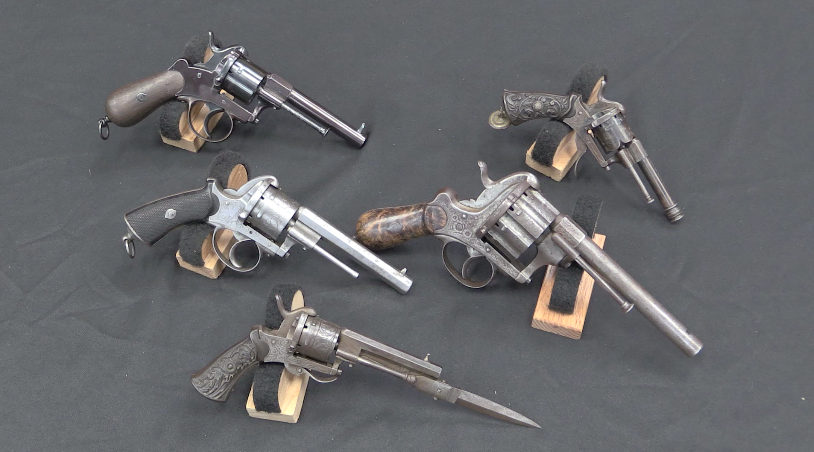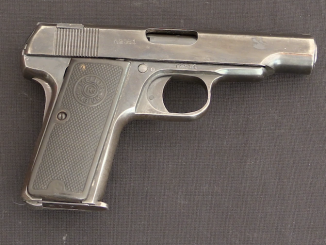In the 1890s, there was a lot of interest in small caliber, simple revolvers for self-defense by cyclists, primarily against dogs. This led to the creation of a whole category of “velodog” revolvers, and a Belgian designer named Herman patented this extension of the idea. It is a 6-shot, 5mm pinfire revolver that is mounted on the handlebars of a bicycle, locked in place and not obviously a gun, but easily removed for one-handed use. Mechanically, it is a simple double-action bar-hammer type pepperbox, but uses in split-pin type of cylinder axis that is unusual and interesting.
Related Articles

Semiauto Rifles
FS2000 at the Range
Yep, it’s a rifle that’s barely 15 years old – but I think it’s on its way to becoming a Forgotten Weapon. So today we have a video on FN’s FS2000 black rifle. It was […]

Revolver
RIA: An Overview of the Pinfire Revolver System
The pinfire system was an early cartridge type which saw widespread use in Europe, but was not widely adopted in the United States. First invented by a French designer named Pauly, it was made commercially […]

Semiauto pistol
New Model Melior: A Remarkably Nice Belgian FN Lookalike
The New Model Melior was patented just before World War One, but did not go into production until 1920. It was a visual lookalike of the FN Model 1910, where the (retroactively named) Old Model […]

Speed and efficiency of deployment is the advantage I can see for this design. No fumbling in clothing to find the gun, which could make you lose your balance and fall over, putting you into an even more vulnerable position. Ian needs to test the ergonomics of pulling out a gun from inside a coat, while still trying to peddle furiously away from the threat.
And yes, once you reach your destination, you pocket the pistol and take it with you.
Ian probably shouldn’t do that. I much like his articles and wish him no harm. Drawing a pistol from inside the jacket on a bike probably means chipped incisors and a bullet would to the leg
“Pepperbox?” Did anyone load these with pepper to discourage dogs?
Odd origin of name for class of pistols;
“The pepper-box pistol or simply pepperbox (also “pepper-pot”, from its resemblance to the household pepper shakers) ”
From : https://en.wikipedia.org/wiki/Pepper-box
“(…)Did anyone load these with pepper to discourage dogs?”
According to https://www.historicalfirearms.info/post/90600504584/velo-dog-revolvers-developed-in-the-late-19th
…Velo-Dog pistols were initially chambered a proprietary 5.5mm Velo-Dog cartridge but later they appeared in a number of small calibres including .22 rimfire and .25ACP calibres. Some of the cartridges were loaded with cork, pepper or dust shot for those who wished to scare off the animals not harm them…
So yes, though reason for using name was different as already noted.
Yes, look up scheintod.
The TRIGGER doubles as a catch-release to deploy the gun?
How often might panicky owners shoot across the inside of their handlebars?
Yes: this is in the details a clever, but in total a really bad idea.
Lots, considering the bumpy ride on old cobblestone streets. This might well be the reason the design did not catch on.
A pistol in a holster on the handle bars would seem more practical. But I am assuming that gentile Europeans did not want to be so crude (like those barbaric Americans) as to ride around doing “open carry”.
“(…)How often might panicky owners shoot across the inside of their handlebars?”
This could be balanced by loading weapon only 5 rounds, in such manner that 1st trigger pull cause hammer to hit empty chamber, as long as you are able to accept ~16% malus to capacity. Though I am wondering what user manual did say about usage.
Even if the design is daft, it does bring up a period of gun usage that is not discussed. I think it is time to do a bit of historic reenactment.
Stage a backup gun match on bicycles. Pepperbox cap & ball pistols, of similar design, are available. Instead of the handle bar holding the pistol, use a holster attached to the handle bar.
The course is marked path, with the number of targets (positioned down low to mimic an attacking dog) to match the number of chambers in the pepper box. The path should include at least one 90 degree turn (to simulate turning down a side street to get away from the dog). The pistol cannot be drawn from the holster until real close to the first target. Scoring includes the time required to cycle along the entire path. This needs to reward very fast travel, as the rider is trying to get away from the dog. And no stopping is allowed. If a target is passed without the rider being able to shoot at it, that is a penalty.
Contestants do the course twice. Once with the gun in the handle bar holster, once with the gun carried in an inside pocket of a bulky jacket (to replicate the fashion of the day)
I can hear the range safety officers screaming from here
Is it because someone with itchy fingers will inevitably shoot himself before the gun is even drawn?
If a competitor takes a tumble, who knows which direction the gun is pointing when it discharges.
“Velo-Dog” is a French contraction of “Velocipede Anti-Dog”, literally “Bicycle anti-dog”. You’re talking about a different culture, one in which taking a potshot at a dog worrying at your pants cuff would likely not result in either criminal or civil action.
“Velo-dog” revolvers came in both pepperbox and conventional persuasions. They were the European equivalent of American sheath-trigger “suicide special” cheap, smallbore pocket revolvers. Unlike the American type, they were almost all double-action, and instead of being .22 rimfire chambered either pinfire or centerfire cartridges.
https://en.wikipedia.org/wiki/Velo-dog
As for the curved shape of the pepperbox grip being a giveaway that it is in fact a firearm, in Europe in the early days of bicycles such curved-ended handlebar grips were quite common. Bicycles were relatively new technology at the time; the “ordinary” with the large front wheel (fans of Patrick McGoohan’s series The Prisoner no doubt remember that type) only date to the mid-1880s. The modern bicycle we know was originally called the “safety” bicycle because when you took a tumble you didn’t have six feet to fall before you hit the ground, as with an “ordinary”. Early “safety” bicycles didn’t even have pedals or rear-wheel drives; you “trotted” yourself along with your feet, as modern-day skateboarders do.
As for the curved-end handlebars, those were suggested by doctors who noticed that bicyclists who took tumbles often ended up with critical internal injuries due to being hit in the lower torso by the straight, blunt ends of their own handlebars. Ruptured spleens and livers were not uncommon, and often fatal results.
Then around the turn of the last century, the motorized bicycle came along, which evolved into the motorcycle. And doctors had an entirely new set of injuries to deal with.
clear ether
eon
“(…)“safety” bicycle (…)”
If you want to know more about said entity then read Cycling Art, Energy, and Locomotion: A Series of Remarks on the Development of Bicycles, Tricycles, and Man-Motor Carriages by Robert P. Scott available at https://gutenberg.org/ebooks/74928
Well there was a little more than “taking a potshot at a dog worrying at your pants cuff”. Not being bitten by a rabid dog was a serious concern at the time.
I really have to question the whole concept, to be quite honest. I think these and other like items were more on the order of “things that nobody really used”, because I’ve never ever seen any accounts of their use in daily records of the time. I’d be willing to be corrected, but in all the reading I did of late 19th Century source material in the form of newspapers and magazines relating to bicycles (something I once had a lot of interest in studying…) I never once saw anything other than advertisements for this sort of stupidity-expressed-in-steel. Nobody was writing about how they’d frightened off or taken down a pack of rabid dogs chasing them, and nobody was recommending the purchase of these things aside from the manufacturers and advertisers.
If I had to come up with a modern equivalent, I’d say it’d have to be one of those corner-shot arrangements that were so popular a few years back; the idea might be workable and put into production, but the actual necessity…? Highly questionable.
I recall as a kid I used to see add for tear-gas revolvers in magazines. I never heard of one being used. You might have the right idea here
Two of the most important early liberators of women were the bicycle and the typewriter.
That and World War I. When the men are away, the ladies hold sway.